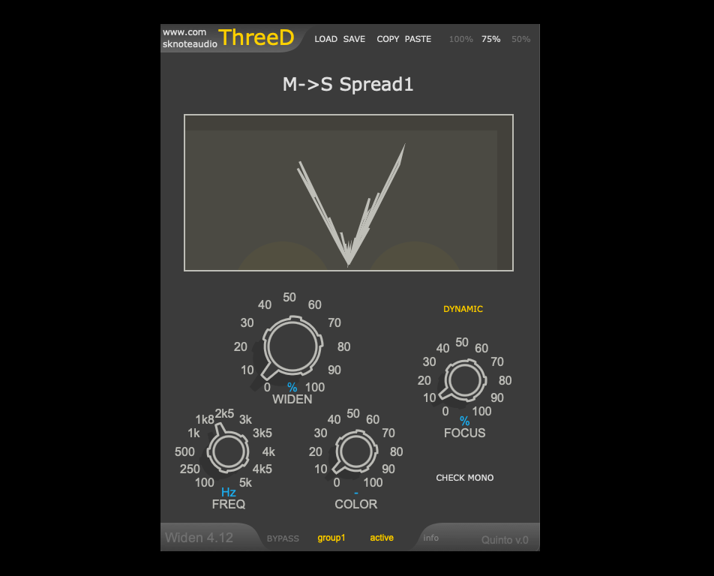ThreeD is our versatile and simple mono-to-stereo widener and stereo-to-stereo enhancement effect.
Includes eleven algorithms.
Based on phase, panning, time.
Mono-to-stereo, stereo-to-stereo, stereo management (mid/side).
Add stereo content to mono sources, where mid/side is not enough.
Add stereo width without adding reverb.
Manage the stereo field in a mix.
Algorithms:
- M->S Spread 1
- M->S Phase
- M->S EQ
- M->S Pan Below
- M->S Pan Above
- M->S Delay
- M->S Ambient
- S->S Phase
- S->S Delay
- S->S Ambient
- S->S Mid/Side
A “Frequency” control sets a threshold for the processing (e.g. keep the lowest frequencies mono while widening the higher range).
With the new v.2 we added several features:
- “Dynamic” mode. Keeps the original stereo image for the transients while processing the sustain and decay. Keeps the original focus on transients.
- Group-Bypass controls. Check the overall effect of the instances on the mix to fine tune the stereo image.
- Check-mono button.
- Copy and paste the settings as a preset (through clipboard, so from instance to instance).
- Scalable interface.
Available in the Webshop as a VST3/AU/AAX plugin for Windows and Mac (including Apple-Native) systems. Price: 29.99$
Downloads available here (it also works in demo mode for seven days):
ThreeD v.2 Mac VST3/AU (universal)
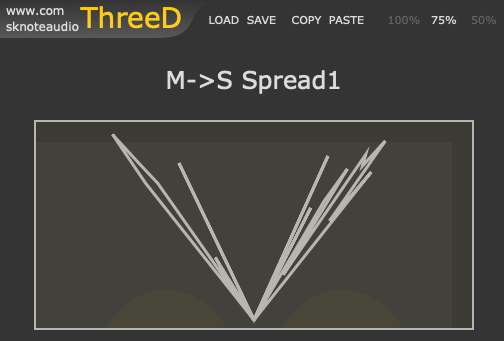
M->S Spread 1
M->S: Stereo input gets summed into mono, then processed and output to stereo.
Frequencies get spread on the sides, with a frequency step set by the Color control.
The Frequency control sets a frequency threshold. Only frequencies above the threshold will be affected while the frequencies below it will stay at the center.
Probably the most transparent algorithm. The most used by us on straight stereo widening of sources in a mix.
Also great to collapse to mono and replace the stereo image of a stereo source (e.g. when a synth has an strong image like lows on left and highs on right and it is not suitable to the mix).
Perfectly mono compatible.
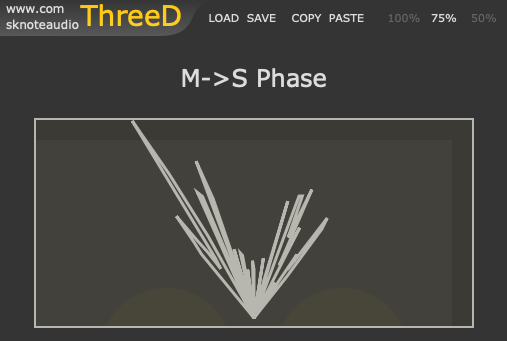
M->S Phase
M->S: Stereo input gets merged to mono, then processed and output as stereo.
Phase filters affect the two sides, so giving stereo width that comes from phase un-alignment between left and right channels. Often quite subtle but very effective.
The Color control sets the position of the phase filters.
The Frequency control sets a frequency threshold. Only frequencies above the threshold will be affectd whil the frequencies below will stay at the center.
It can also be very useful as a phase equaliser, for example with multi-microphone tracking. By affecting one of the tracks themix between the two tracks can have better phase coherency.
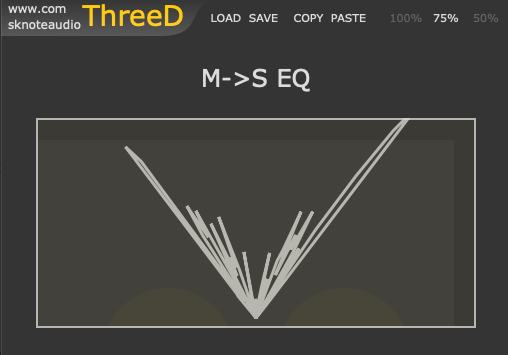
M->S EQ
M->S: Incoming stereo signal gets mixed to mono, processed and output as stereo.
A group of filters splits the signal in two complimentary parts (below and above a cross-over frequency), the two parts are panned separately.
The Frequency control sets the cross-over frequency.
A strong effect, far from natural, very useful on some tracks or on multiple takes (e.g. split the two similar track and pan bands with opposite sign: L-R and R-L).
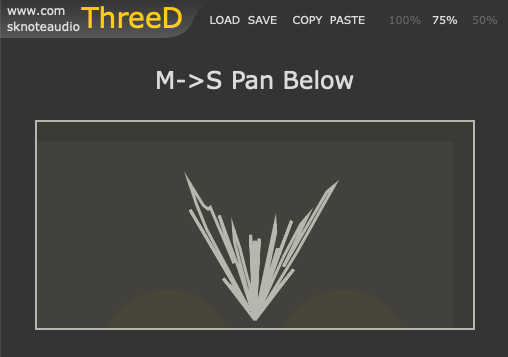
M->S Pan Below
M->S: incoming stereo signal gets mixed into mono, processed then output as stereo.
A set of filters splits the signal in two frequency regions.
The lower region’s panning gets swept between left and right.
The other frequency region is kept to the center.
The Frequency control sets the sweeping speed.
Great on synths. Beware of headaches.
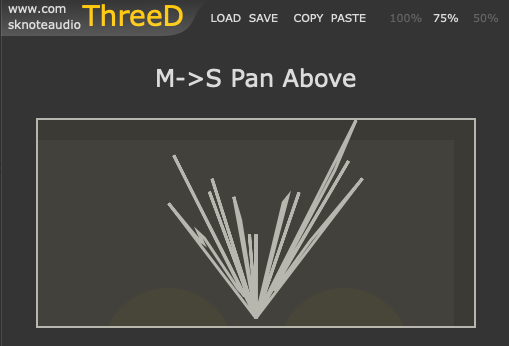
M->S Pan Above
M->S: Incoming signal gets mixed to mono, processed then output as stereo.
Same as previous algorithm but higher frequency range’s panning gets swept while lower region is kept at the center of the stereo image.
More suitable to old-style mixing where the lowest frequencies don’t have too much of stereo image broadening.
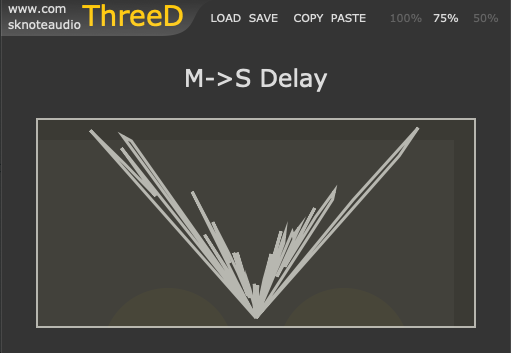
M->S Delay
M->S: incoming signal gets mixed to mono, processed then output as stereo.
Very short delays are introduced and panned to the sides, so generating a stereo image without introducing discrete delay effects.
The Frequency control sets a thresholds: only frequencies above the threshold are affected.
Check the mono-compatibility by the Check Mono control.
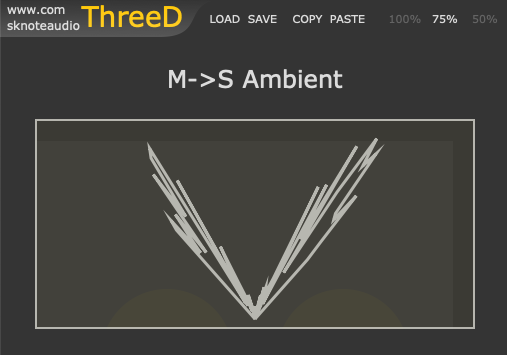
M->S Ambient
M->S: incoming signal gets mixed to mono, processed then output as stereo.
Very short delays are introduced and panned to the sides, so generating a stereo image by introducing ambience.
The Frequency control sets a thresholds: only frequencies above the threshold are affected.
Check the mono-compatibility by the Check Mono control.
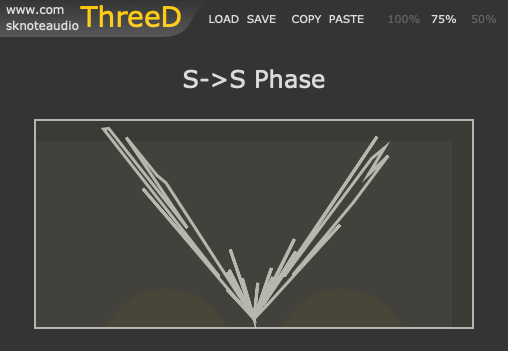
S->S Phase
S->S: incoming signal doesn’t get mixed to mono, they are processed from their original Left-Right position.
Like M->S Phase mode, but with different results (because of how the sides are kept separated).
The Frequency control sets a thresholds: only frequencies above the threshold are affected.
Check the mono-compatibility by the Check Mono control.
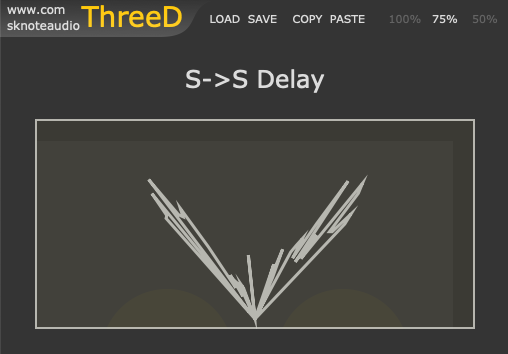
S->S Delay
S->S: incoming signal doesn’t get mixed to mono, they are processed from their original Left-Right position.
Like M->S Delay mode, but with different results (because of how the sides are kept separated).
The Frequency control sets a thresholds: only frequencies above the threshold are affected.
Check the mono-compatibility by the Check Mono control.
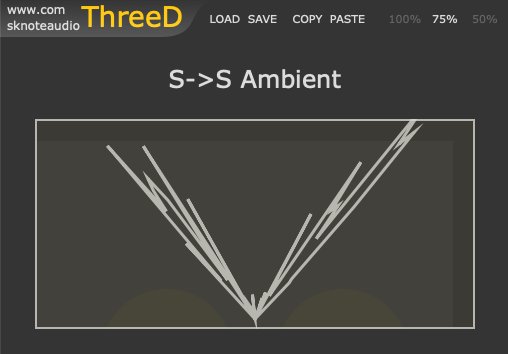
S->S Ambient
S->S: incoming signal doesn’t get mixed to mono, they are processed from their original Left-Right position.
Like M->S Ambient mode, but with different results (because of how the sides are kept separated).
The Frequency control sets a thresholds: only frequencies above the threshold are affected.
Check the mono-compatibility by the Check Mono control.
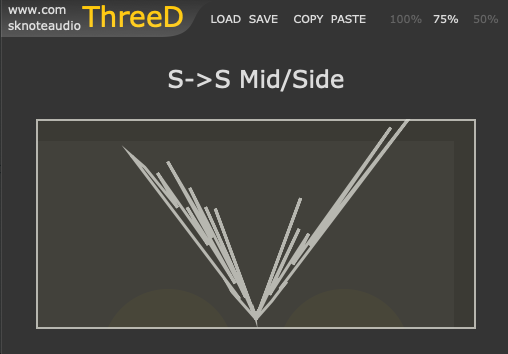
S->S Mid/Side
S->S: incoming signal doesn’t get mixed to mono, they are processed from their original Left-Right position.
Classic Mid-Side balance but only the frequencies above a threshold (set by the Frequency control) are affected, so keeping lowest frequencies’ stereo image untouched.
Check the mono-compatibility by the Check Mono control.
Available in the Webshop as a VST3/AU/AAX plugin for Windows and Mac (including Apple-Native) systems. Price: 29.99$
